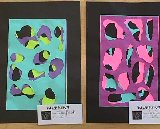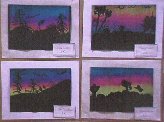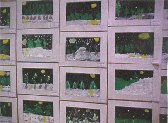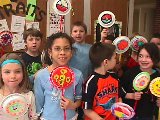| Assessment: | Acceptable Performance Level |
| Completed projects, assessed w/ V.A.Rubric | 3-4 on completed work |
| 2 pieces of art work in art each art show Dec.& May | 3-4 on Report Cards 20/40 weeks |
| CONTENT SEQUENCE
*Skill appears in bold print |
STANDARD AND
PERFORMANCE INDICATORS OF TAUGHT CONTENT AREA |
INTEGRATED CONTENT STANDARD/
P.I. |
METHOD OF ASSESSMENT | ACHIEVED PERFORMANCE LEVELS |
| Realism: concepts of Background, Middle-ground and Foreground in Landscapes in a variety of art media and techniques | 1A, 1C, 1D | Rubric | Developing |
| Concepts of Landscape (Photography) w/ digital cameras (Fall trip to Godfrey’s Pond.) | 2A, 2C, 2D, 2B
3A |
MST
T 5.2A E |
Rubric | Developing
Awareness |
CDOS
2.1A E |
| Written Response to photographs
Focusing on “Ideas and “Organization” |
3A | 6+1 Traits of Writing I, O | 6Traits scoring Rubric | Awareness |
| Silhouetted Landscape:
Rainbow roll technique of Printing; India Ink painted silhouettes cont. concepts Background, Middle ground and Foreground |
1A, 1C, 3B | Rubric | Developing | |
| Torn Paper Seascapes w/ watercolors “If you Sailed on the Mayflower in 1620” Ann McGovern | 1A, 1C | ELA
L&R 2.1A E |
Rubric | Developing |
| Holiday Fine Arts Festival | 1E,2C, 3C | Report Card Gr. | Developing |
| Polar Express
Chris Van Allsburg; (an illustrator’s techniques) Land scape chalk drawings |
1A,1C, 2C, 2D, 3B
3A |
ELA
L&R 2.1A E |
Developing
Awareness |
|
CDOS
2.1A E |
||||
| “Stopping By woods on a Snowy Evening” Robert Frost Drawing | 1A, 1C, 2C, 2D, 3B
3A |
ELA
L&R 2.1A E |
Rubric | Developing
Awareness |
| Tempera landscape Painting “Owl Moon” Jane Yolan | 1A, 1B, 1C, 2D, 3B,
3D |
ELA
L&R 2.1A E |
Rubric | Developing |
| Look at examples of Rhythm instruments from various cultures, create Bead Drums to be used in Music class to create Rhythm | 3C, 4A | Arts
M 2.2B E |
Rubric | Developing |
| Landscapes w/ Kid Pix Technology | 2B, 3B | MST
5.3B |
Rubric | Developing |
| Impressionism Spring Landscape Painting Monet | 1C, 2C, 2D, 3B | Rubric | Developing | |
| Fossils with Clay
Use of Media |
2A, 3C | Rubric | Developing | |
| Lots of Layers Collage
Organic vs. Geometric |
1A, 1C, 3D | MST
M 3.7H E |
Rubric | Developing |
| Aquarium Life Dioramas, underwater projects in a variety of media choices (2nd gr. Aquarium Field Trip) | 2A, 3C | Rubric | Developing | |
| Spring Fine Arts Festival | 1E, 2C, 3C | Report Card Gr. | Developing |






